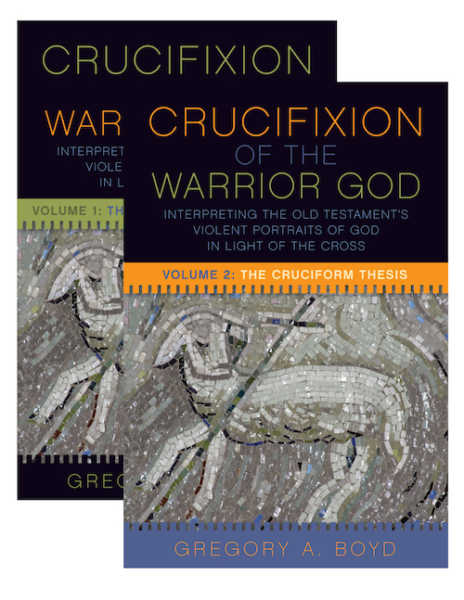We run our website the way we wished the whole internet worked: we provide high quality original content with no ads. We are funded solely by your direct support. Please consider supporting this project.

Crucifixion of the Warrior God Update
Did you know that authors generally don’t have much say-so about the cover art for their books? It’s considered part of the marketing, so the author may or may not like how it ends up looking. I’ve had a few book covers that made me scratch my head. (I won’t tell you which ones, but it would be fun to hear all of your guesses.) That being said, I’m thrilled with these covers, and I wanted to share them with all of you. So exciting!
Here’s the Fortress Press description:
A dramatic tension confronts every Christian believer and interpreter of Scripture: on the one hand, we encounter images of God commanding and engaging in horrendous violence: one the other hand, we encounter the non-violent teachings and example of Jesus, whose loving, self-sacrificial death and resurrection is held up as the supreme revelation of God’s character in the New Testament. How do we reconcile the tension between these seemingly disparate depictions? Are they even capable of reconciliation? Throughout Christian history, many different answers have been proposed, ranging from the long-rejected explanation that these contrasting depictions are of two entirely different ‘gods’ to recent social and cultural theories of metaphor and narrative representation.
The Crucifixion of the Warrior God takes up the dramatic tensions between depictions of divinely sanctioned violence and the message of peace centering the New Testament. Over two volumes, Gregory A. Boyd argues that we must take seriously the full range of Scripture and the centrality of the crucified and risen Christ as God’s supreme revelation. Developing a theological interpretation of Scripture involves what Boyd calls a cruciform hermeneutic. This reading leads us into the proper way of understanding the character of God, revealing God as loving, sacrificial, and subverting violence.
Category: General
Tags: Crucifixion of the Warrior God, Cruciform Theology
Related Reading

Divine Accommodation and the Cross: where Calvin was onto something
Over the last few posts, I’ve been arguing that the cross represents the thematic center of everything Jesus was about. Hence, rather than striving to have a “Christocentric” theology — which is so broad it means next to nothing—we ought to sharpen our focus by striving for a “cruciform” theology. I then offered some suggestions…

Isn’t the Resurrection the Ultimate Revelation of God? (podcast)
Greg considers the relationship between Christ’s death and resurrection. http://traffic.libsyn.com/askgregboyd/Episode_0744.mp3

Podcast: Crucifixion of the Warrior God—The MennoNerds Interview
Paul Walker begins his interview with Greg about Crucifixion of the Warrior God. Paul Walker can be found at MennoNerds. Follow MennoNerds on Twitter. PART ONE: http://traffic.libsyn.com/askgregboyd/Episode_0131.mp3 PART TWO: http://traffic.libsyn.com/askgregboyd/Episode_0132.mp3 PART THREE: http://traffic.libsyn.com/askgregboyd/Episode_0133.mp3 PART FOUR: http://traffic.libsyn.com/askgregboyd/Episode_0134.mp3 PART FIVE: http://traffic.libsyn.com/askgregboyd/Episode_0135.mp3 PART SIX: http://traffic.libsyn.com/askgregboyd/Episode_0136.mp3 PART SEVEN: http://traffic.libsyn.com/askgregboyd/Episode_0137.mp3 PART EIGHT: http://traffic.libsyn.com/askgregboyd/Episode_0138.mp3 PART NINE: http://traffic.libsyn.com/askgregboyd/Episode_0139.mp3 PART TEN: http://traffic.libsyn.com/askgregboyd/Episode_0140.mp3 PART…

Podcast: Is Open Theism an Accommodation?
Or for that matter is accommodation an accommodation? Greg talks about things that impact God. http://traffic.libsyn.com/askgregboyd/Episode_0407.mp3

Did Yahweh Crush His Son?
Though Isaiah was probably referring to the nation of Israel as Yahweh’s “suffering servant” when these words were penned, the NT authors as well as other early church fathers interpreted this servant to be a prophetic reference to Christ. Speaking proleptically, Isaiah declares that this suffering servant was “punished” and “stricken by God” (Isa 53:4,…

Podcast: Does the Cruciform Hermeneutic Sabotage Open Theism?
Greg plays Peek-a-Boo with God and considers whether those verses Open Theists use to support Open Theism might simply be times when God is accommodating for us. http://traffic.libsyn.com/askgregboyd/Episode_0236.mp3
